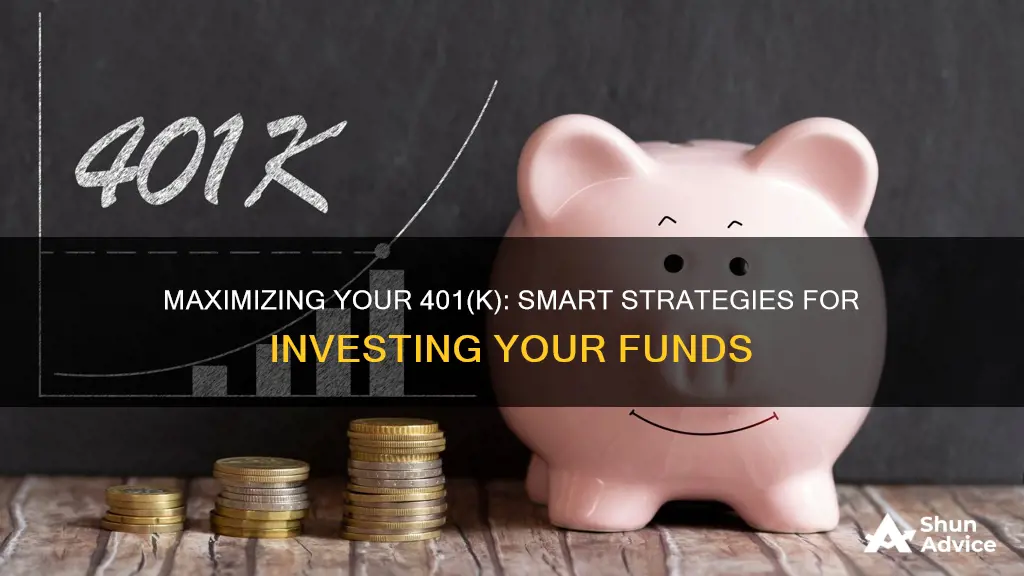
Investing your 401(k) funds is a crucial step in building up your savings for retirement. While opting into a 401(k) plan is generally a straightforward process, it's important to understand how to effectively invest your funds to maximize your savings. Here are some key considerations to help you get started:
- Understand the nature of a 401(k) account: A 401(k) is a tax-advantaged retirement investment account offered by your employer. Contributions to this account are typically made as a percentage of each paycheck, reducing your taxable income.
- Determine your contribution amount: Financial experts recommend contributing as much as you can afford, ideally between 10% to 15% of your income, especially when you're young. Take advantage of any employer match programs, as this is essentially free money toward your retirement.
- Assess your risk tolerance: All investing carries a degree of risk, but you can calculate an appropriate asset allocation between stocks and safer investments like bonds. A common formula is 110 minus your age, which equals the percentage of your portfolio that should be invested in stocks.
- Choose your investments: You'll typically select mutual funds or exchange-traded funds (ETFs) that invest in a variety of companies and sectors. Research funds using platforms like Morningstar, considering factors like fees, performance over time, and the companies and sectors that comprise the fund.
- Consider a target-date fund: If you prefer a more hands-off approach, target-date funds automatically adjust their asset allocation based on your chosen retirement year, becoming more conservative as the date approaches.
- Diversify your portfolio: Diversification helps minimize risk and can enhance long-term returns. Consider investing in a mix of large, medium, and small-cap stocks, as well as bond funds, to balance your portfolio.
- Monitor and adjust your investments: Remember that investing is a long-term strategy. Avoid trying to time the market, and instead, focus on consistently contributing to your 401(k) and periodically rebalancing your portfolio to maintain your desired allocation.
Remember, investing your 401(k) funds is a personal decision that should take into account your unique financial circumstances, goals, and risk tolerance.
| Characteristics | Values |
|---|---|
| Purpose | Retirement savings |
| Risk | Holding cash is risky; investing in stocks and bonds is less so |
| Asset allocation | Depends on age and risk tolerance |
| Investment options | Target-date funds, asset allocation funds, stock funds, bond funds, stable value funds, individual stocks, bonds, ETFs, mutual funds |
| Investment selection factors | Long-term returns, expense ratio |
| Investment management | DIY, robo-advisors, online planning services, target-date funds, managed account services |
| Diversification | Yes, across different sectors and asset classes |
| Rebalancing | Yes, at least annually |
| Investment horizon | Longer horizon allows for more risk |
| Investment amount | Ideally 10-15% of income |
What You'll Learn

Understand what a 401(k) is
A 401(k) is a retirement investment account offered by your employer. It is a "tax-advantaged" investment account, meaning that the money you contribute to it each year, typically a percentage of each paycheck, lowers your taxable income. This tax break is designed to incentivise you to save for retirement now.
There are two types of 401(k) accounts: the traditional 401(k) and the Roth 401(k). The latter is offered by fewer employers and involves contributing money that has already been taxed. When you withdraw money from a Roth 401(k) in retirement, you do not pay taxes.
Like a savings account or individual retirement account (IRA), a 401(k) is simply a type of financial account. Once you contribute money to your 401(k), you must then invest the money in stock or bond funds, otherwise it will remain as cash.
If you leave your employer, your 401(k) account will usually remain with the financial firm that originally managed it, unless you roll it over to a new company or have contributed little to it. You can generally start withdrawing money from your 401(k) penalty-free at 59 1/2. Withdrawing money before this age will usually result in a 10% early withdrawal penalty and you will have to pay income taxes on the distributions.
Not all employers offer their employees a 401(k) plan. If your employer does not offer a 401(k), you can open an IRA, which also offers tax advantages for those investing for retirement, through a brokerage firm.
Target Maturity Funds: A Guide to Investing Wisely
You may want to see also

Determine how much you can contribute
The amount you can contribute to your 401(k) depends on several factors, including your age, income, debt level, and other financial goals. While there are maximum contribution limits set by the IRS, contributing as much as possible—especially when you are young—is generally recommended by financial experts.
For 2024, the maximum amount an individual can contribute to their 401(k) is $23,000, an increase from $22,500 in 2023. This limit applies to both Roth 401(k) and traditional 401(k) plans. It's important to note that this is the total amount an individual can contribute across all their 401(k) accounts, even if they have multiple accounts with different employers.
If you are aged 50 or older, you are eligible to contribute additional "catch-up" amounts. For 2023 and 2024, this catch-up contribution limit is $7,500, bringing the total contribution limit to $30,500 for individuals aged 50 and above.
Financial experts advise that you should contribute at least enough to get your full employer's match, if applicable. Typically, companies offer a match on contributions up to a certain dollar amount or percentage, with the average employer 401(k) match being 4.7%.
As a general guideline, it is recommended to save at least 15% of your income each year for retirement, including any employer contributions. Starting early and contributing consistently over time will make the biggest difference in the size of your savings.
It's important to note that contributing too much to your 401(k) can result in costly penalties. Most 401(k) plans have infrastructure in place to prevent over-contributions, but if you switch jobs mid-year or have access to multiple plans, you may accidentally save too much. Therefore, it's crucial to monitor your contributions to ensure they don't exceed the annual limits.
Equity Funds: When to Invest for Maximum Returns
You may want to see also

Calculate your risk tolerance
When it comes to investing your 401(k) funds, it's important to understand your risk tolerance—the degree of risk that you, as an investor, are willing to take on. This is influenced by various factors, and it's crucial to determine your risk tolerance before deciding how to allocate your investments. Here are some key considerations to help you calculate your risk tolerance:
Age and Investment Goals
Your age is a significant factor in assessing your risk tolerance. Generally, younger investors with a longer time horizon until retirement are considered more risk-tolerant. They are often willing to invest more in stocks and stock funds, as they have more time to recover from potential losses. On the other hand, older investors with a shorter investment horizon tend to have a lower risk tolerance and may prefer less volatile options. However, it's important to note that age is not the sole determining factor, as people are living longer, and medical advancements are extending life expectancies.
Income and Financial Situation
Your financial situation, including your income, net worth, and available risk capital, plays a crucial role in determining your risk tolerance. Investors with higher incomes, substantial net worth, and more liquid capital can typically afford to take on more risk. They have a larger buffer to withstand potential losses and are not solely dependent on their investments for income. In contrast, those with limited financial resources may need to be more conservative in their investment approach to ensure they don't take on more risk than they can comfortably manage.
Risk Capacity and Volatility
Risk tolerance is closely linked to an investor's risk capacity, which refers to their financial ability to take on risk. It's important to assess how much risk you can realistically take on given your financial situation. Additionally, consider your tolerance for volatility in the value of your investments. Stocks, for instance, tend to be more volatile and carry higher risk, while bonds are often seen as safer investments with lower risk.
Personal Risk Tolerance and Anxiety
Apart from financial considerations, it's essential to evaluate your personal risk tolerance and anxiety levels. Some individuals are more comfortable with risk and volatility, while others prefer a more conservative approach to avoid anxiety about market fluctuations. It's crucial to be honest with yourself about your risk tolerance to ensure your investment strategy aligns with your comfort level.
Time Horizon and Goals
The time horizon for your investments is another critical factor. If you have long-term financial goals with a longer time horizon, you may have the potential for greater returns by investing in higher-risk assets. On the other hand, if you have short-term goals or need access to your funds in the near future, lower-risk investments may be more appropriate.
Risk Tolerance Assessments and Historical Returns
To help determine your risk tolerance, you can utilise online risk tolerance assessments, surveys, or questionnaires. These tools can provide valuable insights into your risk tolerance level. Additionally, reviewing historical returns for different asset classes can help you understand the volatility and potential risks associated with various investment options.
By considering these factors and assessing your personal situation, you can gain a clearer understanding of your risk tolerance. This, in turn, will guide your investment decisions and help you build a 401(k) portfolio that aligns with your financial goals and comfort level. Remember, investing always carries some level of risk, and it's important to carefully consider all aspects of your financial situation before making any investment decisions.
Mutual Funds Philippines: Best Time to Invest
You may want to see also

Pick your investments
Once you've decided how much to contribute to your 401(k), you need to choose your investments. If you don't, your contributions will sit in a money market account. You can't usually invest in individual companies through a 401(k), so you'll need to select one or more mutual funds or exchange-traded funds (ETFs). These invest in a variety of companies and sectors, and your company's 401(k) plan will offer a small selection of stock and bond funds, ranging from conservative to more aggressive.
You'll need to do some research before making your selection. You can assess each fund by searching its name on Morningstar, which will give you information on its fees, performance over time, and what companies, sectors, stocks and/or bonds make up the fund. You can also search the fund's name on Google to research its holdings, allocation, and more.
When assessing a fund, look at its long-term returns over five and 10-year periods, as well as its expense ratio (the cost to hold the fund for a year as a percentage of the money invested). You'll need to make a trade-off between performance and expenses. While you might be willing to pay a higher fee for the prospect of better long-term returns, be careful about buying any fund that has only performed well recently but has delivered mediocre performance over longer periods.
You can also consider a target-date fund, which takes most of the guesswork out of the equation. With these funds, you select a "target" retirement year and risk tolerance, and the fund automatically sets an appropriate asset allocation for you. Over time, the fund will automatically rebalance, becoming more conservative as you near retirement.
If you're looking to manage your portfolio yourself, you'll want to keep some important principles in mind:
- Consider your financial goals: If you want higher returns, your portfolio likely needs to have more invested in stock funds.
- Diversify: A diversified portfolio helps minimize risk and may help increase your long-term returns.
- Assess your risk tolerance: Avoid taking on too much risk. You want to have a portfolio that grows but also allows you to sleep at night.
- Evaluate your time horizon: The more time you have until you need the money, the more risk you can take and the higher the returns you can generate.
Best Vanguard Funds for Your IRA: Top Picks
You may want to see also

Go with the simplest option
Investing in a 401(k) is one of the main ways that US workers save for retirement. However, only about a third of Americans understand how a 401(k) works, which can cause people to put off investing altogether.
If you're unsure about how to invest your 401(k), one option is to go with a target-date fund. This is the simplest option and takes most of the guesswork out of the equation. With these funds, you select a "target" retirement year and risk tolerance, and the fund automatically sets an appropriate asset allocation for you.
Here's how it works:
- You choose a target retirement year and your risk tolerance.
- The fund is then automatically set to an appropriate asset allocation for you, taking into account factors such as your age, financial goals, and risk tolerance.
- Over time, the fund will automatically rebalance, becoming more conservative as you near retirement.
Target-date funds are a great option for beginner investors or those who don't want to actively manage their 401(k). They help to create a diversified portfolio and take the stress out of investing. However, it's important to note that you'll likely pay more for this type of fund, and it's important to do your research to ensure the fund's mix of stocks and bonds aligns with your risk tolerance.
Overall, if you're looking for a simple and straightforward way to invest your 401(k), a target-date fund is a great option to consider.
Insurance Company Investment Strategies: Where Does the Money Go?
You may want to see also
Frequently asked questions
A 401k is a retirement investment account offered by your employer. It is a "tax-advantaged" investment account, meaning the money you contribute to it each year, typically a percentage of each paycheck, lowers your taxable income.
You'll need to consider your financial goals, risk tolerance, and time horizon. You'll then want to diversify your portfolio by investing in a mix of stocks, bonds, and other assets. You can do this yourself or choose a target-date fund, which will automatically adjust its allocation over time based on your retirement date.
There are a few potential risks to consider. Firstly, being too conservative with your investments can hurt your long-term returns. Secondly, paying too much in fees can eat into your investment returns. Lastly, there is always the risk of investment losses, as stocks and bonds can decline in value, especially over short periods.
It depends on your individual circumstances, particularly your time horizon until retirement. If you have a long time horizon, you may prefer more aggressive stock funds that can provide stronger long-term growth. As you near retirement, you may want to shift to more conservative options like dividend stock funds or bond funds to protect your accumulated earnings.







